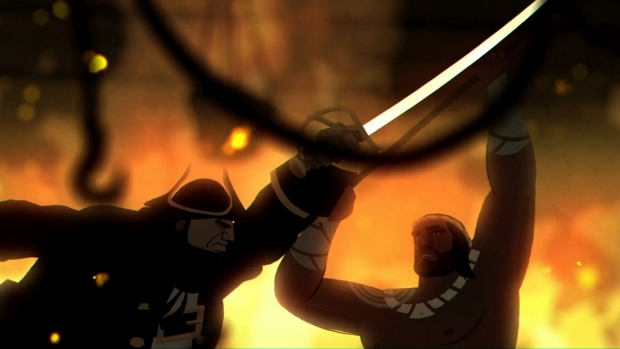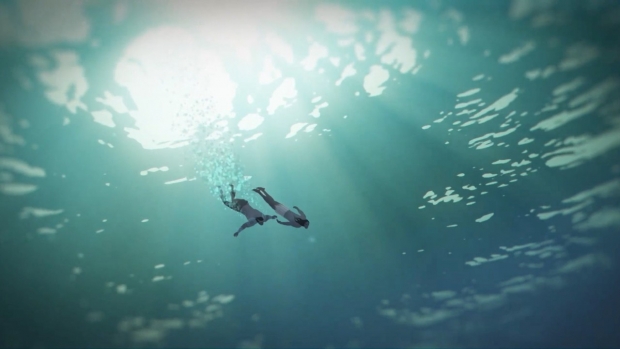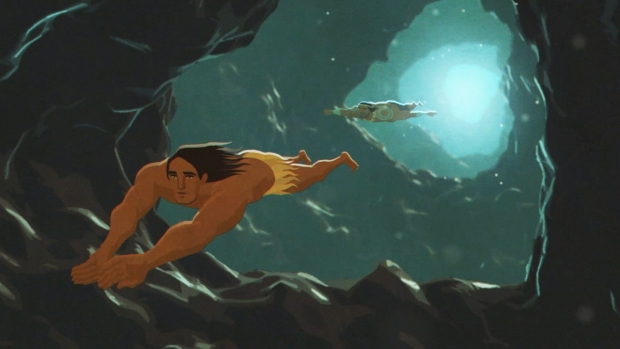In the new short from Dean Hamer, Joe Wilson, and Daniel Sousa, the team behind the award-winning ‘Kapaemahu,’ an island warrior who descends into a strange underwater world after being wounded in battle falls in love with the shapeshifting octopus that saves his life.
When Dean Hamer and Joe Wilson first began their journey as partners in life and in filmmaking, they knew they wanted to tell the stories of love and oppression experienced by Polynesian people. Hawaii has been their long-time home and, at times, personal paradise. Their heart was, and still is, with the island people and that devotion to tell their stories took a new form with their first animation, Kapaemahu, released in 2020, which tells the story of the long-suppressed four-boulder monument in Waikiki and the people, both male and female in mind and body, who brought science and healing to the island.
Kapaemahu earned numerous film awards and was the centerpiece of a major exhibition last year at the Bishop Museum in Honolulu. So, when Hamer and Wilson came up with another animated short film idea for Kanaka Pakipika, the production company they formed with Hawaiian teacher Hinaleimoana Wong-Kalu – the narrator of Kapaemahu - it makes sense why they thought going with the same animation style of their recent success would be the right move.
But the new short, Aikane, had a voice of its own to share – despite the absence of dialogue – which required unique visual inspiration from not only Hawaii but also Ireland, Africa, and Greece.
“We collaborate with Kumu Hina and many other people to try to lift up Hawaiian and Pacific stories in particular, but this story was not born out of a particular Hawaiian historical understanding,” explains Wilson. “It was born out of the universal understanding that in cultures around the world, throughout time, people are people. And same-gender-loving people have existed everywhere for all time. The film has a Hawaiian name. But it’s broader and deeper than that.”
Aikane – a title derived from the ancient Hawaiian term for intimate same-sex friends, particularly cherished by aliʻi nui (chiefs) – tells the story of an island warrior who descends into a strange underwater world after being wounded in battle. When the octopus who rescues him shapeshifts into a handsome young man, sparks fly, and an epic adventure begins. Love, trust, and courage are the glue that binds the unlikely couple together in their fierce battle against foreign invaders. The short, also inspired by Wilson and Hamer’s love of diving Oahu’s colorful waters, is eligible for Oscar Shorts voting beginning Thursday, December 14.
Enjoy the film, then learn more about its production:
“As far as we are aware, there have been no previous films about Aikane, at least not explicitly so,” says Wong-Kalu, a producer on the film. “The reason why is the same as why there were few, if any, films about Mahu before Kapaemahu: My people have been colonized, dominated, and brainwashed for so long that many of our most important traditions and ways of thinking have been all but lost. That’s exactly why we are making these pieces - to recover our past.”
This excavation of the past through Aikane extends around the world, as Wilson got to sift through his family heritage for an already deeply personal film by including Celtic-inspired patterns in the green-tinted body paint that the warrior characters wear.
“My grandmother was from Ireland and there's a famous Irish epic called, in English, The Cattle Raid of Cooley, which prominently features two, what we would today call, queer warriors as the central figures,” says Wilson. “I did want to find those relationships between this idea that queer love is universal, just like any other form of love and intimacy. So, I was really happy that there was an Irish correlation to all of this.”
Daniel Sousa, Aikane’s director and animator, adds, “We were also looking at landscapes from different parts of the world, from my home in Cape Verde to the basalt formation on the Isle of Man and those in Iceland. We were looking at Greek mythology and ancient myths and that's something that’s always attracted me, this idea that mythology can speak to universal truths, and that there is something archetypal about myths that are shared between different cultures. Even cultures that have never encountered one another can sometimes come up with the same creation myths and stories. I think that's fascinating. It’s something that's in our DNA.”
A good example of not just relationship dynamics shared globally but also myths and legends shared across cultures is Wilson and Hamer’s accidental inclusion of an iconic Hawaiian creation story. Turns out, after two decades living on the island, some Hawaiian stories start revealing themselves on their own.
“When we started the project, we explained to Hina that there wasn't, as far as we knew, any myth or legend that was perfect for the story we wanted to tell and so we were going to create our own and just be really clear that this is an original story, completely fiction,” recalls Hamer. “I chose to use an octopus in the film because they’re amazing and incredibly intelligent animals. This was also after My Octopus Teacher had come out and Joe and I had actually seen the tail end of one once when we were diving. It wasn’t until we were basically finished with the film that we reviewed it with Hina, and she goes, ‘This is a Hawaiian legend.’”
Wong-Kalu explains, “According to ‘The Kumulipo,’ the Hawaiian creation story, our world emerged from the ruins of another. Everything we see today was formed anew but for one survivor from a previous age: the octopus. The godly form of the octopus is Kanaloa, the ruler of the ocean, who is very friendly – some even say Aikane – with Kane, the god of creation. So, the ‘imaginary legend’ Dean wrote actually has a strong parallel in Hawaiian tradition. It seems that this story, like so many, reflects some deep understanding that is shared across the world.”
The eclectic mix of cultures and universality of the story is largely what contributed to the decision to keep the film pantomime, rather than include any narration or dialogue.
“It was a bit of a philosophical decision,” shares Hamer. “I wanted the film to be understood by even a young kid. And pantomime has such a deep history with animation, and it's so readily understood, that I thought it would keep the story focused on the actions of the characters. And it became clearer and clearer that the stiff formality of Kapaemahu wasn't right for this film at all, and I started watching more and more Disney and Pixar films with lots of love, lots of interactions, and lots of high play.”
The way characters eyes move, the way they stand, and, especially, the way they swim all speak to the film’s unsaid words. Sousa says his trip to visit Hamer and Wilson in Honolulu for Kapaemahu’s museum exhibition in 2022 was a big help in getting a better understanding of their underwater world and how to create a picture worth a thousand words.
“I come from a history of making films that are all in pantomime,” says Sousa, known for his work on shorts like Fable (2006) and Feral (2012). “But I know very little about the ocean. Dean and Joe are avid divers and go swimming every day off the coast of Hawaii, so they're very familiar with the color palettes of the coral reefs, the lighting, and the movements under water. That was something they wanted to bring to life in the movie. It was an education for me to delve into that world a little bit myself.”
For Sousa, what resonated with him the most about the film were the tones of colonization that made a more prominent appearance in the latter half of the story.
“Cape Verde is a place that was colonized by the Portuguese, and they brought slaves from Senegal, in West Africa, and that was the culture,” says Sousa. “That idea of indigenous people colonized by foreigners was definitely close to my own personal history.”
There are so many layers to Aikane’s storytelling in its themes, symbolism, visuals, and overall tone. And it’s not lost on the team, which acknowledges the massive challenge in seeing it all get done right… and get done at all.
“We started with a script long enough for a feature film, and I think we’ve done a pretty good job with it,” says Sousa. “We were pretty brutal in taking out entire sections and moving things around until it started to feel right. I think we spent about six weeks on the animatic and designs and then moved on to rough animation. The whole thing took about a year.”
“I would also like to point out that Daniel did everything,” shares Hamer. “From the drawings to the final composition, he truly did everything.”
Hamer, Wilson, and their team hope this story of love, epic battles, breathtaking landscapes, and living fully submerged (sometimes literally) in power and light, like Kapaemahu, will open more doors for reengaging with stories of the past – regardless of society’s bigotry and hate – that educate viewers on the history of the world. And maybe even stories of their own history.
“We do hope, in the future, to bring to life the true stories of some of Hawaii’s most important Aikane, such as Kamehameha III and Kaomi, who co-ruled Oahu in the early 1800s,” says Wong-Kalu. “There are always those who try to impose their beliefs and ways of being on others, no matter the harm they may cause. Our message with the film is that love, in all its diverse forms, is stronger and can overcome.”













